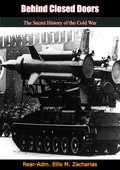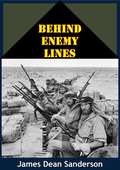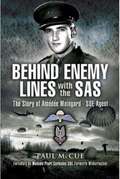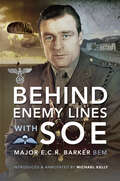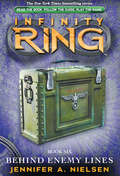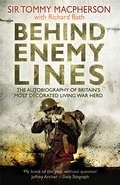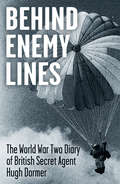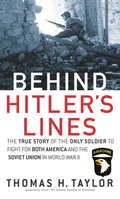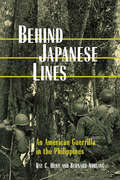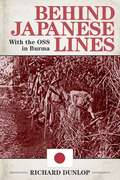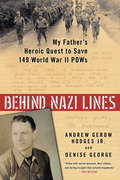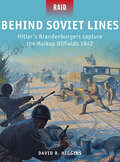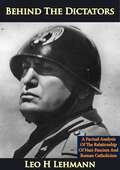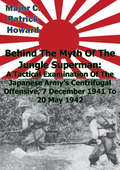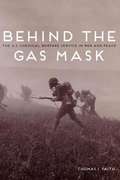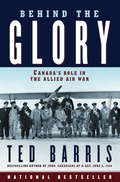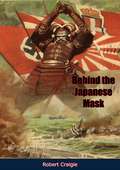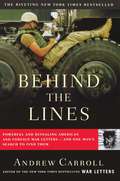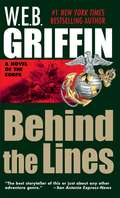- Table View
- List View
Behind Closed Doors (Made in Montana)
by Debbi RawlinsThis cowboy's ready to ride! Beth Wilson has clearly lost her mind. What sane woman ditches a successful career so she can move to Montana and renovate a run-down boardinghouse? But when her much-needed building supplies are sent to reclusive rancher Nathan Landers-every girl's naughty cowboy fantasy-Beth is set for a showdown! Nathan just wants to run his ranch in peace, but Beth's determination-and gorgeous long legs-are a serious distraction. Feeding the local rumor mill is more than he can handle, though. So the only way to indulge in a deliciously hot little tryst is to ensure that no one ever suspects. But in the tiny town of Blackfoot Falls, Montana, there's no such thing as a secret....
Behind Closed Doors: The Secret History of the Cold War
by Rear-Adm. Ellis M. ZachariasThis book focuses on how the former Soviet Union stole American missile secrets and proposed steps to prevent further espionage and is based on former Rear-Admiral Ellis Zacharias’ files in naval intelligence and his war-time experiences.
Behind Enemy Lines
by James Dean SandersonTerror, Torture, Death...It was kill first or be killed for these men who fought their own private hit-and-run war.True accounts of World War II heroic secret raiders whose daring missions behind enemy lines changed the course of the war. Ten accounts of high courage and dedication--stories of the suicidal missions of the World War II.""Courage knows no nationality"--and it might be added--bounds--which a collection of now-it-can-be-told tales attempts to prove. Mr. Sanderson's stories focus on surpassing daring, audacity and cunning--to match any act of heroism on the field of battle. Usually these intrepid escapades were the work of one ingenious planner; sometimes, however, whole crews engaged in death-defying sorties. The writing catches the spirit of these men with realism and drama, whether the story deals with an incredible plot to kill Rommel (which didn't come off); the disposal of an embryonic Nazi A bomb in Norway in 1943; a "cockleshell" raid along a Nazi-held river; or the grim humor of Britain's only private, "independent" army--Popski's Army, fighting alongside the Tommies in Tunisia.... Good cloak-and-dagger stuff that points up the fact that even the Armed Services had great need of wildly imaginative non-conformists.... For the boys--or men--who are commandos in spirit."-Kirkus Reviews
Behind Enemy Lines with the SAS: The Story of Amédée Maingard, SOE Agent
by Paul McCueAmde Maingard was a young Mauritian studying in London in 1939 who volunteered for the British Army. After a frustrating spell in the infantry, Maingard joining the Special Operations Executive (SOE) and later had a successful career as a leader and peace keeper in France and later Mauritius. Maingard returned to Mauritius and was instrumental in developing the islands tourism and hotel industry. Founder and first Chairman of Air Mauritius, he became one of his countrys most successful postwar businessmen before illness cut short his ambition and he died in 1981 at the age of 62.
Behind Enemy Lines with the SOE
by Ernest BarkerWith his special forces training completed, Sergeant Roland Barker was allocated to Operation Arundel as its radio operator. Led by Major Bill Smallwood, he was parachuted into the Dolomites in 1944. The team’s brief was to cause havoc in the area around the Italian border and to infiltrate into Austria. During the mission, Major Smallwood was injured in a fall and was unable to move rapidly. Despite their best efforts, both Smallwood and Barker were subsequently captured by pursuing German troops who they were unable to outpace. Barker provides a vivid account of being ‘interrogated’ by the SS and Gestapo and despite the threats and the terrible conditions, the true nature of their mission was never revealed to the enemy. Having survived these experiences, he was incarcerated in Stalag Luft XVIII in Southern Austria. Ever defiant, Barker escaped by having himself admitted to the camp hospital and made his way into Hungary, from where, as this account of his wartime service reveals, he was eventually repatriated to the UK. After the war Barker opted to remain in the Army, at which point he took a commission. Promoted to Major, Barker became the Officer Commanding 22 SAS in Malaya. He was killed in a helicopter crash in Malaya in 1953, before he could see through his plan to have his memoir published.
Behind Enemy Lines with the SOE
by Ernest BarkerWith his special forces training completed, Sergeant Roland Barker was allocated to Operation Arundel as its radio operator. Led by Major Bill Smallwood, he was parachuted into the Dolomites in 1944. The team’s brief was to cause havoc in the area around the Italian border and to infiltrate into Austria. During the mission, Major Smallwood was injured in a fall and was unable to move rapidly. Despite their best efforts, both Smallwood and Barker were subsequently captured by pursuing German troops who they were unable to outpace. Barker provides a vivid account of being ‘interrogated’ by the SS and Gestapo and despite the threats and the terrible conditions, the true nature of their mission was never revealed to the enemy. Having survived these experiences, he was incarcerated in Stalag Luft XVIII in Southern Austria. Ever defiant, Barker escaped by having himself admitted to the camp hospital and made his way into Hungary, from where, as this account of his wartime service reveals, he was eventually repatriated to the UK. After the war Barker opted to remain in the Army, at which point he took a commission. Promoted to Major, Barker became the Officer Commanding 22 SAS in Malaya. He was killed in a helicopter crash in Malaya in 1953, before he could see through his plan to have his memoir published.
Behind Enemy Lines: Behind Enemy Lines (Infinity Ring #6)
by Jennifer A. NielsenFix the past. Save the future.World War II is raging across Europe, and the Axis and Allied powers are in a stalemate. Dak, Sera, and Riq can tip the scales in the Allies' favor . . . if they can pull off the most daring spy mission of all time. But even if they succeed, are they playing into the SQ's hands?Jennifer A. Nielsen, author of THE FALSE PRINCE, brings her talent for intrigue and suspense to the Infinity Ring series!
Behind Enemy Lines: The Autobiography of Britain's Most Decorated Living War Hero
by Richard Bath Sir Tommy MacphersonWith three Military Crosses, three Croix de guerre, a Légion d'honneur and a papal knighthood for his heroics during the Second World War, Sir Tommy Macpherson is the most decorated living soldier of the British Army. Yet for 65 years the Highlander's story has remained untold. Few know how, aged 21, he persuaded 23,000 SS soldiers of the feared Das Reich tank column to surrender, or how Tommy almost single-handedly stopped Tito's Yugoslavia annexing the whole of north-east Italy. Twice captured, he escaped both times, marching through hundreds of miles of German-held territory to get home. Still a schoolboy when war broke out, Tommy quickly matured into a legendary commando, and his remarkable story features a dizzyingly diverse cast of characters, including Winston Churchill, Field Marshal Montgomery and Charles de Gaulle.
Behind Enemy Lines: The World War Two Diary of British Secret Agent Hugh Dormer
by Hugh DormerBehind Enemy Lines: The World War Two Diary of British Secret Agent Hugh Dormer, first published in 1948 as Hugh Dormer's Diaries, is the gripping war-time account of Captain Hugh Everard Dormer, D.S.O., Irish Guards. Dormer twice parachuted into Nazi-occupied France with the objective of destroying an important shale oil processing plant. After each mission, Dormer made his way back to England by crossing into Spain on foot via the Pyrenees Mountains. Following the Normandy invasion, Dormer commanded a British tank crew which was shelled at close-range by a German tank. Dormer and two crewmen managed to escape the burning tank but Dormer was killed by machine-gun fire as he and the crewmen attempted to escape across an open meadow (the other two men were wounded and taken prisoner). Dormer, who was only 25 years old at the time of his death, was remembered fondly by all those who served with him, and had hoped to become a priest following the war. His dedication and heartfelt belief in the moral justness of the Allied cause provide a timeless story of courage and inspiration.
Behind Hitler's Lines: The True Story of the Only Soldier to Fight for both America and the Soviet Union in World War II
by Thomas H. TaylorAs the twentieth century closed, the veterans of its defining war passed away at a rate of a thousand per day. Fortunately, D-Day paratrooper Joseph Beyrle met author Thomas H. Taylor in time to record Behind Hitler's Lines, the true story of the first American paratrooper to land in Normandy and the only soldier to fight for both the United States and the Soviet Union against Nazi Germany. It is a story of battle, followed by a succession of captures, escapes, recaptures, and re-escapes, then battle once more, in the final months of fighting on the Eastern Front. For these unique experiences, both President Bill Clinton and President Boris Yeltsin honored Joe Beyrle on the fiftieth anniversary of V-E Day. Beyrle did not strive to be a part of history, but history kept visiting him. Twice before the invasion he parachuted into Normandy, bearing gold for the French resistance. D Day resulted in his capture, and he was mistaken for a German line-crosser - a soldier who had, in fact, died in the attempt. Eventually Joe was held under guard at the American embassy in Moscow, suspected of being a Nazi assassin. Fingerprints saved him, confirming that he'd been wounded five times, and that he bore a safe-conduct pass written by marshal Zhukov after the Wehrmacht wrested Joe, at gunpoint, from execution by the Gestapo. In the ruins of Warsaw his life was saved again, this time by Polish nuns. Some of Joe's story is in his own words - a voice that will be among the last and best we hear firsthand from World War II.
Behind Japanese Lines: An American Guerrilla in the Philippines
by Ray C. Hunt Bernard NorlingThis WWII combat memoir offers a rare firsthand account of the Allied guerilla forces fighting the Japanese occupation of the Philippines. In the Spring of 1942, US and Philippine forces lost the Battle of Bataan, leaving control of the Bataan Peninsula and the island of Corregidor to the Japanese. After the devastating loss, the Allied forces stationed across the Philippine Archipelago were supposed to surrender. Yet many of them refused, escaping into the mountains and jungles to form guerilla units. In Behind Japanese Lines one of those brave soldiers, Ray Hunt, recounts his experiences as part of the Allied resistance against the Japanese occupation. After escaping the Bataan Death March, Ray organized a troop of guerillas who went on to make noteworthy contributions to the Filipino-American reconquest of the Philippines. Ray&’s story sheds important light on US-Filipino relations during World War II, as well as the realities of fighting both the Imperial Japanese Army and the Hukbalahap communist guerillas."Stands out for the vividness of its detail, its effort to sort fact from legend, and its tribute to the heroism of the resistance movement, which was almost entirely Filipino.&” —Choice
Behind Japanese Lines: With the OSS in Burma
by Richard DunlopIn early 1942, with World War II going badly, President Roosevelt turned to General William "Wild Bill" Donovan, now known historically as the "Father of Central Intelligence," with orders to form a special unit whose primary mission was to prepare for the eventual reopening of the Burma Road linking Burma and China by performing guerilla operations behind the Japanese lines. Thus was born OSS Detachment 101, the first clandestine special force formed by Donovan and one that would play a highly dangerous but vital role in the reconquest of Burma by the Allies.Behind Japanese Lines, originally published in 1979, is the exciting story of the men of Detachment 101, who, with their loyal native allies-the Kachin headhunters-fought a guerilla war for almost three years. It was a war not only against a tough and unyielding enemy, but against the jungle itself, one of the most difficult and dangerous patches of terrain in the world. Exposed to blistering heat and threatened by loathsome tropical diseases, the Western-raised OSS men also found themselves beset by unfriendly tribesmen and surrounded by the jungle's unique perils-giant leeches, cobras, and rogue tigers.Not merely a war narrative, Behind Japanese Lines is an adventure story, the story of unconventional men with an almost impossible mission fighting an irregular war in supremely hostile territory. Drawing upon the author's own experiences as a member of Detachment 101, interviews with surviving 101 members, and classified documents, Dunlop's tale unfolds with cinematic intensity, detailing the danger, tension, and drama of secret warfare. Never before have the activities of the OSS been recorded in such authentic firsthand detail.
Behind Nazi Lines
by Denise George Andrew Gerow HodgesIn 1944, hundreds of Allied soldiers were trapped in POW camps in occupied France. The odds of their survival were long. The odds of escaping, even longer. But one-man had the courage to fight the odds . . . An elite British S.A.S. operative on an assassination mission gone wrong. A Jewish New Yorker injured in a Nazi ambush. An eighteen-year-old Gary Cooper lookalike from Mobile, Alabama. These men and hundreds of other soldiers found themselves in the prisoner-of-war camps off the Atlantic coast of occupied France, fighting brutal conditions and unsympathetic captors. But, miraculously, local villagers were able to smuggle out a message from the camp, one that reached the Allies and sparked a remarkable quest by an unlikely--and truly inspiring--hero. Andy Hodges had been excluded from military service due to a lingering shoulder injury from his college-football days. Devastated but determined, Andy refused to sit at home while his fellow Americans risked their lives, so he joined the Red Cross, volunteering for the toughest assignments on the most dangerous battlefields. In the fall of 1944, Andy was tapped for what sounded like a suicide mission: a desperate attempt to aid the Allied POWs in occupied France--alone and unarmed, matching his wits against the Nazi war machine. Despite the likelihood of failure, Andy did far more than deliver much-needed supplies. By the end of the year, he had negotiated the release of an unprecedented 149 prisoners--leaving no one behind. This is the true story of one man's selflessness, ingenuity, and victory in the face of impossible adversity.
Behind Soviet Lines-Hitler's Brandenburgers capture the Maikop Oilfields 1942
by Johnny Shumate David HigginsWith his forces having conquered a huge swathe of formerly Soviet territory in the months following the launch of Operation Barbarossa in June 1941, Hitler planned to continue the Germans' strategic offensive against the Soviet Union's oil-production capacity in the southern Caucasus region during the summer of 1942. To help pave the way for regular forces, the Abwehr (German military intelligence) sent forward 'Brandenburger' commando units to pave the way using tactics that had proven successful throughout the previous Western and Balkan campaigns. These commandos would secure oil-producing assets until more conventional forces from 1. Panzerarmee and 17. Armee could arrive in strength. Specially trained in foreign cultures and military vehicles, small-unit tactics, parachuting, sabotage, reconnaissance, assassination and deception techniques, these elite commandos usually operated in company-sized units or smaller and recruited many 'non-Aryan' native speakers of those languages spoken in the target countries.In early August 1942, a small Brandenburger unit of Baltic and Sudeten Germans led by Freiherr Adrian von Fölkersam penetrated far ahead of German regular forces to seize Soviet oil facilities around Maikop. Disguised as members of Stalin's NKVD, the repressive police organisation dreaded by most Soviet citizens and soldiers, Fölkersam's command passed through the Soviet front lines using captured trucks and moved deep into hostile territory, where the chaos of the Soviet battlefield situation aided in their passing as 'official'. As regular German forces approached after several days, the Brandenburgers went into action using grenades to simulate an artillery attack before disabling Maikop's military communication network. Having previously seen Fölkersam with their commander, and lacking any communications to rebut or confirm his statement, the Soviets began to evacuate Maikop at Fölkersam's urging. The German spearhead entered the city on 9 August 1942 against minimal resistance and found that several oil-production facilities were still functioning.Featuring specially drawn full-colour artwork and expert analysis of the Maikop operation, this assessment of the dramatic raid that delivered intact Soviet oil-production facilities into Nazi hands casts new light of the German special-forces operations on the Eastern Front.
Behind The Dictators: A Factual Analysis Of The Relationship Of Nazi-Fascism And Roman Catholicism
by Leo H LehmannBehind the Dictators by Leo H. Lehmann is a bold and meticulously researched exploration of the connections between Nazi-Fascist regimes and elements within the Roman Catholic Church. Through compelling analysis and historical documentation, Lehmann delves into the complex relationship between political authoritarianism and religious influence in 20th-century Europe.In this provocative work, Lehmann examines the ideological and practical alliances that emerged between key figures in the Catholic hierarchy and fascist leaders like Adolf Hitler and Benito Mussolini. He explores how shared interests, ranging from anti-communism to the consolidation of power, forged unlikely alliances and influenced the political landscape of the time. Drawing from historical records, speeches, and firsthand accounts, Lehmann provides a detailed and critical account of these interactions, revealing the extent to which religion and politics intersected during one of history’s darkest periods.While unflinching in its critique, Behind the Dictators also contextualizes the broader historical, social, and economic pressures that shaped these alliances. Lehmann’s analysis serves as both a historical study and a cautionary tale about the potential dangers of intertwining religious authority with political power.Ideal for readers interested in history, political science, or the dynamics of religion and power, Behind the Dictators offers a thought-provoking and challenging perspective on the role of institutions during times of upheaval. This book is a compelling resource for anyone seeking to understand the undercurrents that shaped the political and religious alliances of the 20th century.
Behind The Myth Of The Jungle Superman: A Tactical Examination Of The Japanese Army’s Centrifugal Offensive, 7 December 1941 To 20 May 1942
by Major C. Patrick HowardThis thesis studies the successful Japanese Centrifugal Offensive of 1941-42. The Japanese lacked realistic strategic objectives for the offensive, and the Imperial Japanese Army (IJA), which was trained and equipped to fight the Soviet Army on the plains of Manchuria, had neither sufficient logistics structure nor appropriate equipment for a dispersed jungle campaign. Despite these severe strategic and operational failings, IJA tactical units achieved all of their objectives within six months. This study uses government documents, untranslated Japanese sources, and secondary works to examine the conscription system, training methods, equipment, and tactical doctrine that the IJA employed during the Centrifugal Offensive.The study concludes that the IJA's aggressive training methods produced a skilled army that easily adapted to the unfamiliar jungle terrain of the Southwest Pacific. While the IJA's equipment was usually ill suited for battle against the Soviets, Japanese emphasis on light weight unintentionally made the IJA's standard issue items eminently suitable for jungle operations. Likewise, the IJA's doctrine was ideal for a short, offensive jungle campaign. The Centrifugal Offensive provides evidence to the modern military leader that well-trained soldiers will adapt to unfamiliar situations without special training, and that junior leaders can learn initiative through instruction and conditioning.
Behind the Black Door
by Sarah BrownIn this personal memoir about life at 10 Downing Street, Sarah Brown shares the secrets of living behind the most famous front door in the world.Sarah gave up a successful career in business to serve the country. A passionate campaigner for women and children, she mobilised over a million people through her early adoption of Twitter.If you've ever wondered what it's like to pack for a photo call with supermodels or pause a speech in front of hundreds when the autocue fails, it's all here - from what to do when the school play clashes with a visit to the White House to what it feels like to support the man you love as he takes tough decisions to stave off global financial meltdown...Intimate, reflective, surprising and funny, Behind the Black Door takes us backstage to reveal what it's like to be an ordinary woman, wife and mother in extraordinary circumstances.
Behind the Front
by Craig GibsonUntil now scholars have looked for the source of the indomitable Tommy morale on the Western Front in innate British bloody-mindedness and irony, not to mention material concerns such as leave, food, rum, brothels, regimental pride, and male bonding. However, re-examining previously used sources alongside never-before consulted archives, Craig Gibson shifts the focus away from battle and the trenches to times behind the front, where the British intermingled with a vast population of allied civilians, whom Lord Kitchener had instructed the troops to 'avoid'. Besides providing a comprehensive examination of soldiers' encounters with local French and Belgian inhabitants which were not only unavoidable but also challenging, symbiotic and uplifting in equal measure, Gibson contends that such relationships were crucial to how the war was fought on the Western Front and, ultimately, to British victory in 1918. What emerges is a novel interpretation of the British and Dominion soldier at war.
Behind the Gas Mask: The U.S. Chemical Warfare Service in War and Peace
by Thomas I FaithIn Behind the Gas Mask, Thomas Faith offers an institutional history of the Chemical Warfare Service, the department tasked with improving the Army's ability to use and defend against chemical weapons during and after World War One. Taking the CWS's story from the trenches to peacetime, he explores how the CWS's work on chemical warfare continued through the 1920s despite deep opposition to the weapons in both military and civilian circles. As Faith shows, the believers in chemical weapons staffing the CWS allied with supporters in the military, government, and private industry to lobby to add chemical warfare to the country's permanent arsenal. Their argument: poison gas represented an advanced and even humane tool in modern war, while its applications for pest control and crowd control made a chemical capacity relevant in peacetime. But conflict with those aligned against chemical warfare forced the CWS to fight for its institutional life--and ultimately led to the U.S. military's rejection of battlefield chemical weapons.
Behind the Glory: Canada's Role in the Allied Air War
by Ted BarrisIn this 60th anniversary edition is Ted Barris’ telling of the unique story of Canada’s largest World War II expenditure – $1.75 billion in a Commonwealth-wide training scheme, based in Canada that supplied the Allied air war with nearly a quarter of a million qualified airmen. Within its five-year life-span, the BCATP supplied a continuous flow of battle-ready pilots, navigators, wireless radio operators, air gunners, flight engineers, riggers and fitters or more commonly known as ground crew, principally for the RCAF and RAF as well as the USAAF. While the story of so many men graduating from the most impressive air training scheme in history is compelling enough, Ted Barris offers the untold story of the instructors – the men behind the glory – who taught those airmen the vital air force trades that ensure Allied victory over Europe, North Africa and the Pacific. In Winston Churchill’s words, the BCATP proved "the decisive factor" in winning the Second World War. This 60th anniversary edition arrives as Canada continues to celebrate 2005 as the Year of the Veteran. Ted Barris interviewed more than 200 instructors and using their anecdotes and viewpoints he recounts the story of the flyers who coped with the dangers of training missions and the frustration of fighting the war thousands of miles away from the front without losing their enthusiasm for flying.
Behind the Japanese Mask: A British Ambassador In Japan, 1937-1942 (The\kegan Paul Japan Library)
by Robert CraigieBehind the Japanese Mask tells the story of political events in Japan leading up to and during World War II, as told by the British Ambassador in Japan from 1937-1941 himself, Sir Robert Leslie Craigie.“THIS BOOK IS IN NO SENSE AN OFFICIAL RECORD. IT IS RATHER AN ATTEMPT, made without reference to official documents and after three years of mature reflection, to disentangle from avoidable detail the sequence of political events in Japan which led up to the war; to record the main developments in Anglo-Japanese relations during that time; and to follow the intricacies of the struggle in Japan between those who favoured this war of aggression and those who worked against it. Interspersed with political matters I have given accounts of our personal experiences, not because I regard them as intrinsically important, but rather in the hope that they may help to give body to the general impressions formed during those five critical years in Japan. The views expressed are purely my own and in no way commit His Majesty’s Government.“‘Know thine enemy’ is a good precept for those who have been engaged on a life-and-death struggle with a foe who is as inscrutable as he has often shown himself to be unscrupulous. If this book can add but a little to the sum of that knowledge, I shall be more than satisfied.”—Sir Robert Leslie Craigie
Behind the Lines
by Andrew CarrollFrom the editor of the phenomenal New York Times bestseller War Letters comes an even more powerful, more revealing collection of rare and previously-unpublished letters from every major war in American history -- all discovered during Andrew Carroll's extraordinary three-year journey throughout the U.S. and to thirty-five countries around the world."
Behind the Lines
by W.E.B. GriffinBehind the Lines is W. E. B. Griffin's powerful novel of World War II -- and the courage, patriotism, and sacrifice of those who fought it.By 1942, the Japanese have routed the outnumbered American forces and conquered the Philippines. But deep in the island jungles, the combat continues. Refusing to surrender, a renegade Army officer organizes a resistance force and vows to fight to the last man. A Marine leads his team on a mission through the heart of enemy territory. And the nation's proudest sons fight uncelebrated battles that will win -- or lose -- the war . . .
Behind the Lines
by W.E.B. GriffinBehind the Lines is W. E. B. Griffin's powerful novel of World War II -- and the courage, patriotism, and sacrifice of those who fought it.By 1942, the Japanese have routed the outnumbered American forces and conquered the Philippines. But deep in the island jungles, the combat continues. Refusing to surrender, a renegade Army officer organizes a resistance force and vows to fight to the last man. A Marine leads his team on a mission through the heart of enemy territory. And the nation's proudest sons fight uncelebrated battles that will win -- or lose -- the war . . .
Behind the Lines
by W.E.B. GriffinBehind the Lines is W. E. B. Griffin's powerful novel of World War II -- and the courage, patriotism, and sacrifice of those who fought it.By 1942, the Japanese have routed the outnumbered American forces and conquered the Philippines. But deep in the island jungles, the combat continues. Refusing to surrender, a renegade Army officer organizes a resistance force and vows to fight to the last man. A Marine leads his team on a mission through the heart of enemy territory. And the nation's proudest sons fight uncelebrated battles that will win -- or lose -- the war . . .

